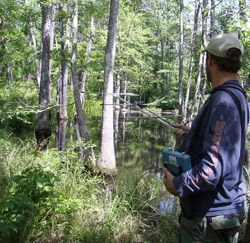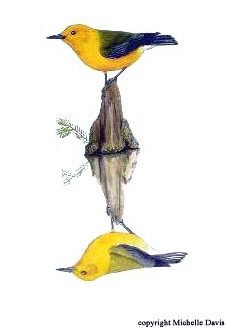RESEARCH ACTIVITY
Radar Component -
Weather surveillance radar is a useful tool for
the detection, monitoring
and quantification of the movement of birds in the
atmosphere. As such, radar is capable of addressing
questions about broad geographic scale movements
over various time scales. Over the course of a migration
season, for example, radar provides an indication
of where and how frequently migratory flights are
made. The Clemson
University Radar Ornithology Lab will
use WSR-88D (weather surveillance radar – 1988
Doppler) radar in conjunction with GIS to delimit the
amount of bird migration passing over Fort Polk and Kisatchie
National Forest during spring and fall migration. Although
weather surveillance radar can be used to determine areas
where migrants stopover, it provides only a rough indication
of density in relation to habitat type and little, if
any, information on species, much less age, sex or energetic
condition. Consequently, radar information is most valuable
when integrated with data at the next [“on the
ground”] level of analysis.
Census Component – During the
peak of 2006 spring migration we quantified abundance
and diversity of
landbird migrants by means of surveying protocols.
These data can be used to address daily and within-season
patterns of migration. ERDC also conducted these surveys
during fall migration of 2005. Similar surveys will
be conducted during fall of 2006 and spring of 2007
across multiple habitat types.
Telemetry Component - At the local and habitat scale,
radio-telemetry can be used to study the movement pattern
of migrants in relation to landscape variables. For
example, radio-telemetry can be used in conjunction
with translocation experiments designed to test predictions
about patch occupancy: How do migrants react to patch
size, habitat boundaries, habitat type? Radio-telemetry
also helps us to understand how migrants make decisions
about habitat use during stopover. Radio-telemetry
can provide insight into stopover duration, temporary
home range size, and exploratory behavior of migrants,
as well as whether the factors of habitat patch size
and placement within the landscape also affect the
availability and suitability of stopover habitat for
birds.
Banding Component- During the peak of 2006 spring
migration we used mist-nets to band migrants in hardwood,
pine, and mixed pine-hardwood in Kisatchie National
Forest. Presumably migrants select particular habitats
to enhance their fitness. Although the effect of habitat
use on fitness (i.e., survival and reproductive success)
is difficult to estimate during migration, more immediate
consequences of habitat use can be measured in relation
to how well migrants satisfy energy demand and meet
other exigencies that arise during stopover. Mist-nets
were used to capture migrants in selected habitats
to measure the energetic condition of migrating birds
in relation to habitat. Despite radar indicating that
there were large passages of migrants during the time
we were banding, we did not catch many migrants after
considerable effort during the spring of 2006. Because
migrants may not be concentrated enough in any one
area within this landscape, we plan to focus more on
following individual birds using radio-tracking during
2007 spring migration.
|
 |
